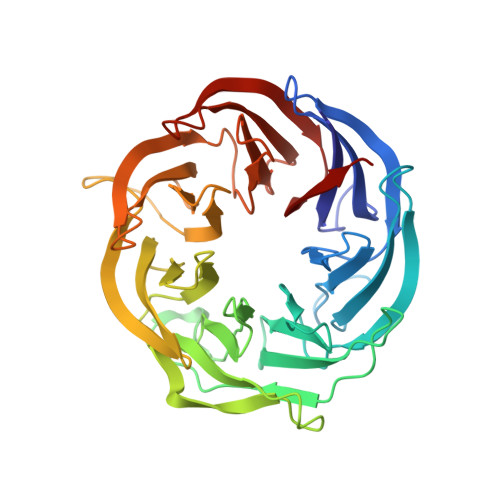Structural and Functional Insights into PpgL, a Metal-Independent beta-Propeller Gluconolactonase That Contributes toPseudomonas aeruginosaVirulence.
Song, Y.J., Wang, K.L., Shen, Y.L., Gao, J., Li, T., Zhu, Y.B., Li, C.C., He, L.H., Zhou, Q.X., Zhao, N.L., Zhao, C., Yang, J., Huang, Q., Mu, X.Y., Li, H., Dou, D.F., Liu, C., He, J.H., Sun, B., Bao, R.(2019) Infect Immun 87
- PubMed: 30642898
- DOI: https://doi.org/10.1128/IAI.00847-18
- Primary Citation of Related Structures:
6IGB - PubMed Abstract:
Biofilm formation is a critical determinant in the pathopoiesis of Pseudomonas aeruginosa It could significantly increase bacterial resistance to drugs and host defense. Thus, inhibition of biofilm matrix production could be regarded as a promising attempt to prevent colonization of P. aeruginosa and the subsequent infection. PpgL, a periplasmic gluconolactonase, has been reported to be involved in P. aeruginosa quorum-sensing (QS) system regulation. However, the detailed function and catalysis mechanism remain elusive. Here, the crystal structure of PpgL is described in the current study, along with biochemical analysis, revealing that PpgL is a typical β-propeller enzyme with unique metal-independent lactone hydrolysis activity. Consequently, comparative analysis of seven-bladed propeller lactone-catalyzing enzymes and mutagenesis studies identify the critical sites which contribute to the diverse catalytic and substrate recognition functions. In addition, the reduced biofilm formation and attenuated invasion phenotype resulting from deletion of ppgL confirm the importance of PpgL in P. aeruginosa pathogenesis. These results suggest that PpgL is a potential target for developing new agents against the diseases caused by P. aeruginosa .
Organizational Affiliation:
Center of Infectious Diseases, State Key Laboratory of Biotherapy, West China Hospital, Sichuan University and Collaborative Innovation Center, Chengdu, China.
















